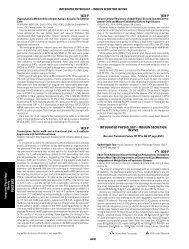Pro-inflammatory CD11c CD206 adipose tissue ... - Diabetes
Pro-inflammatory CD11c CD206 adipose tissue ... - Diabetes
Pro-inflammatory CD11c CD206 adipose tissue ... - Diabetes
You also want an ePaper? Increase the reach of your titles
YUMPU automatically turns print PDFs into web optimized ePapers that Google loves.
morphology and LDH activity of the<br />
supernatant was not significantly different<br />
between groups. Adipocytes were then were<br />
washed in KRP buffer (136mM NaCl, 4.5mM<br />
KCL, 1.25mM CaCl2, 1.25mM MgCl2,<br />
0.6mM Na2HPO4, 0.4mM NaH2PO4, 10mM<br />
HEPES, 0.1% BSA), incubated at 37º C for<br />
20 minutes in 40µL KRP ± insulin before<br />
addition of 10µL KRP containing 0.25mM<br />
unlabeled 2-deoxyglucose and 0.1µCi tritiated<br />
2-deoxyglucose (PerkinElmer) for a further<br />
10 minutes. Cells were then washed with icecold<br />
PBS containing 80mg/L phloretin<br />
(Sigma) before lysis in 0.1M NaOH, transfer<br />
into UltimaGold scintillant (PerkinElmer) and<br />
β-scintillation counting. Counts (cpm) were<br />
corrected for cell-free blanks. The intra-assay<br />
CV for replicate control wells was 5-18%.<br />
Quantitative PCR and gene microarray: RNA<br />
was prepared from cell pellets using a<br />
Picopure RNA kit (Arcturus, CA). DNA was<br />
prepared by proteinase K digestion and<br />
ethanol precipitation. Primer sequences are<br />
shown (Supplemental Table 2). Amplification<br />
efficiencies of primer pairs were not<br />
significantly different over the concentration<br />
ranges measured. For RT-PCR, total RNA<br />
was reverse-transcribed using Superscript III<br />
(Invitrogen) and amplified on an ABI Prism<br />
7700 platform using the Sybergreen reporter<br />
(Qiagen, CA). Gene expression relative to βactin<br />
was determined using the comparative<br />
CT method.<br />
Gene microarray of <strong>CD11c</strong> - and<br />
<strong>CD11c</strong> + <strong>CD206</strong> - ATMs was performed using<br />
50ng total RNA and HumanWG-6 v2<br />
BeadChips (Illumina, CA). Microarray<br />
analysis used the lumi, limma and annotation<br />
packages of Bioconductor (48). Expression<br />
data was background- corrected using<br />
negative control probes followed by a<br />
variance stabilising transformation (49) and<br />
quantile normalisation. Gene-wise linear<br />
10<br />
Adipose <strong>tissue</strong> macrophages in human obesity<br />
models were fitted to determine differences<br />
between cell populations, taking into account<br />
subject-to-subject variability. Significant<br />
differentially expressed genes were identified<br />
using empirical Bayes moderated t-tests and a<br />
false discovery rate of 5% (50). Functional<br />
annotation clustering analysis (25) of<br />
differentially expressed genes was performed<br />
online (www.david.abcc.ncifcrf.gov) using<br />
default settings.<br />
Statistical analysis: Statistical analyses were<br />
performed with Prism v5.0a software for<br />
Macintosh (Graphpad, San Diego). Pairs of<br />
groups were compared by the Mann-Whitney<br />
test or Wilcoxon matched pairs test as<br />
appropriate. Multiple groups were analysed<br />
by ANOVA, with Neuman-Keuls post-test<br />
comparisons of group pairs. Correlation was<br />
determined by Spearman rank-log test. p
















